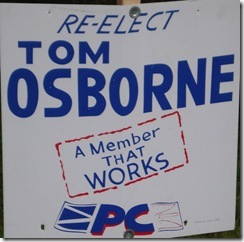Credit where credit is due correction: see bottom of post
Justice minister Felix Collins is creating a gigantic mess.
In February, Collins announced that the provincial government had proclaimed the 2001 tobacco costs recovery act and would now get on with filing a lawsuit against Big Tobacco as a number of other states and provinces have done.
The very last sentence of the news release included this supposedly innocent bit of information:
The Provincial Government has retained the services of local law firm Roebothan McKay Marshall, who will be provided with foreign legal advice from Humphrey, Farrington and McClain of Independence, Missouri, experts in tobacco litigation.
Note the words: “Provincial government has retained…”.
Only problem was no one outside of a handful of people in the provincial government had ever learned that Danny Williams’ former law firm had anything to do with the suit.
No tender call.
No expressions of interest.
Nothing.
The Official Opposition tried to find information through an access to information request. As Opposition Leader Yvonne Jones put it in the House of Assembly on Monday, “there was no record of any cost-benefit analysis, no minutes of any meetings that discuss the issue, no internal letters, memos or emails, …”.
No records at all?
Sounds odd, but this is a government, after all, that wanted to charge someone 10 large for copies of public speeches.
Lots of work because someone had to redact the speeches they said.
Anyway, when asked about it, Collins put it this way:
…when the time came to expedite this process and to file the statement of claim, the American company still did not have the certificate to practice so we had to engage in the firm they had retained to file their statement of claim. It is as simple as that, Mr. Speaker.
February news release was about filing the statement of claim.
Collins said on Monday that the provincial government hired the firm at that point.
Following the story, so far?
Another question and Collins added some more detail:
Mr. Speaker, there was provision in that agreement that that law firm would retain Newfoundland counsel to act on their behalf in this Province. Mr. Speaker, they engaged the services of Roebothan McKay Marshall to be their agent in this Province.
So it was the American law firm that hired the local firm.
Okay.
And then this bit:
Mr. Speaker, about a month ago when we filed our statement of claim, we had to engage with Roebothan McKay Marshall to do that for us because up to that point in time the American company did not have the certificate of practice.
So now it looks like the provincial government didn’t hire the firm, as the February release says. That was the crowd from Missouri.
And then – in the words of second rate television reporters everywhere - things started going horribly wrong for Felix.
Jones asked about the contract with Roebothan, McKay and Marshall.
Collins retorts with:
the hon. the Leader of the Opposition knows full well the details because they were the ones who entered into the contract with the firm to start with.
Huh?
Suddenly a contract with a law firm that was supposedly signed within the past couple of months actually happened seven or eight years ago?
Looks like another Time Lord is born to go with the fish one and the old justice one.
Switch now to Tuesday when Jones took up the saga again.
Collins explains:
We had to revise that agreement in December to make the local counsel, the counsel for the purposes of expediting the process in the court, as I mentioned yesterday. That is the only revision, Mr. Speaker.
Whoa, Felix.
All this changing of agreements and there’s no record of any kind of it in the provincial government?
Apparently so.
But something else changed in all this as well: under the original deal, the Missouri firm took the lead, based on its experience. They got the job as a result of a competitive process. These Americans took on a local firm on a subcontract, if you follow Collins’ line on Monday.
But then he dropped this zinger:
We had to revise the document to make the local firm the lead counsel so that they could expedite this process and bring the statement of claim into court.
“Make the local firm the lead counsel.”
Huge difference.
But Collins wasn’t done. Having rattled his own argument with a series of earthquakes and a tsunami, he blew the reactor sky-high:
Roebothan McKay Marshall has been involved in this file for at least five, six years, at least five or six years…
Not five or six weeks, as you had on Monday or implicit in the February news release.
Five or six years.
Now just recall that somewhere in government there is enough information on all this so that someone could write a briefing note for Collins to read, but there wasn’t anything they’d release under an open records law.
But now the world learns that Danny’s old law firm started working on this file way back when Danny was in his first term in office.
Five or six years ago would make it around 2005 or 2006. Tom Marshall – Danny’s west coast leadership campaign boss – was the justice minister.
Wow.
That eye-searing white light you see is Felix Collins’ credibility going up in a ball of nuclear flame.
It’s going to be interesting to see if the fireball engulfs anyone else inside or outside the administration.
- srbp -
Correction: Blogging is not an exact science and sometimes even when you know the right answer you still get it wrong.
Full credit for the backstory on this belongs to Russell Wangersky at the Telegram. Your humble e-scribbler humbly got it wrong when he attributed this to the opposition.
Wangersky’s your man and he laid it out back in February.





